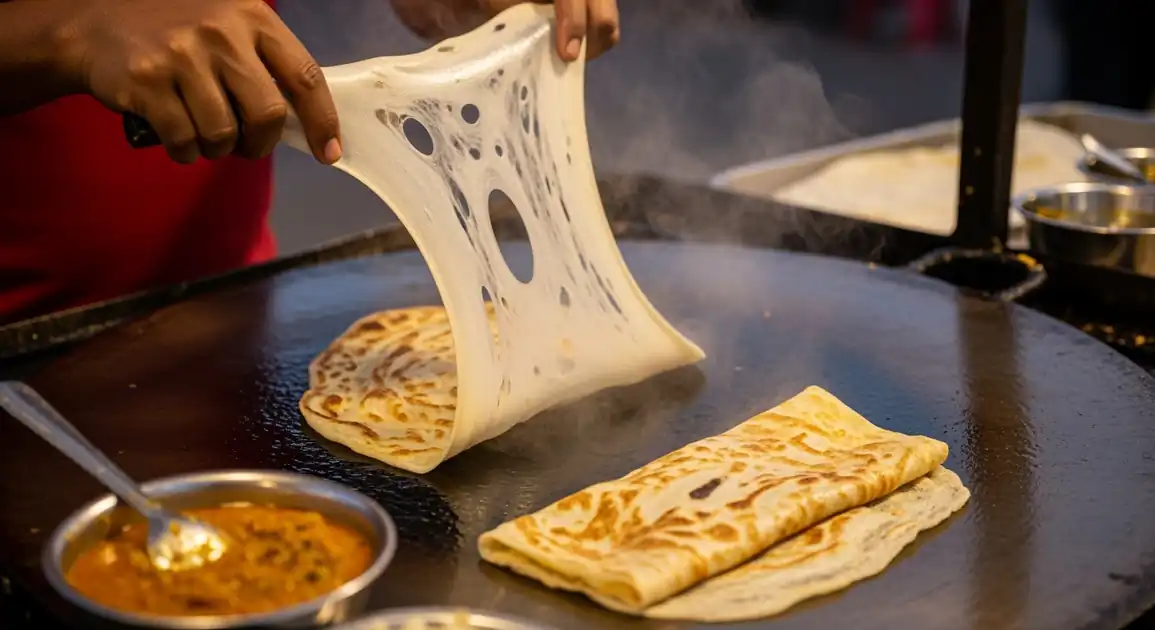Gothamba Roti (Sri Lankan Roti)
ගෝදම්බ රොටී

Description
Galle, with its historic fort and coastal setting, offers plenty of opportunities to enjoy Gothamba Roti. You'll find numerous 'Roti Kades' and small eateries both inside and outside the Fort area, often bustling in the evenings. Look for stalls near the bus stand, market areas, and along streets leading to the Fort.
Dietary Information
Serving information
Serving style
Typically served folded on paper or a small plate, accompanied by dhal curry and sometimes Pol Sambol. Eaten by hand.
Quick facts
Mainly 4 PM to 11 PM or midnight, especially outside the Fort.
Safety Tips
What to Look For
-
Roti cooked fresh to order
Ensures the roti is hot, cooked through, and hasn't been sitting out, reducing risk of contamination and ensuring best texture.
-
Vendor skillfully stretches dough thinly
Indicates experience and proper technique, often correlates with better quality and taste. Thin layers cook faster and more evenly.
-
Hot and clean griddle ('tawa')
A very hot surface ensures quick cooking and kills surface bacteria. It should be reasonably clean, free from excessive old burnt bits.
-
High customer turnover
Suggests the roti is popular and ingredients are likely fresh.
-
Hygienic handling of dough and fillings
Look for clean hands or utensils used for handling dough and adding fillings. Separate handling for raw/cooked items if applicable.
What to avoid
-
Pre-cooked roti sitting in a pile for a long time
Roti loses its texture and can become contaminated if left at room temperature.
-
Dirty griddle or preparation surfaces
Increases the risk of cross-contamination from old food residues or dirt.
-
Fillings (especially meat/egg) that look old or aren't cooked fresh
Risk of bacterial growth in fillings not kept properly hot or cooked thoroughly.
-
Visible cross-contamination between raw ingredients (if any) and cooked roti
Poor hygiene practices can transfer pathogens.
-
Vendors handling money and food without washing hands/changing gloves
Common source of contamination transfer.
Price information
Price range
Budget tips
- Prices might be slightly higher within the Galle Fort tourist area compared to outside.
- Stalls near the main bus stand and market offer competitive local prices (Plain Roti 40-70 LKR, Egg Roti 80-150 LKR).
- Filled Roti like Fish or Chicken might be 100-200 LKR.
- Look for smaller, busy local 'hotels' for good value.
Value indicators
- Expert stretching and flipping visible.
- Served piping hot off the griddle.
- Good balance of flaky and soft texture.
- Freshly made accompanying curries (especially Dhal).
Where to Find This Dish
Galle Bus Stand Area
Numerous food stalls, including popular Roti Kades, cater to travelers and locals.
Main Bus Stand, Galle Railway Station (nearby)
Evening, Night
Outside Galle Fort (Main Road)
Along the main roads leading towards and around the Fort entrance.
Sea Street (Weli Devala Road), Roads near Galle International Stadium
Evening, Night
Galle Market Area
Around the main vegetable and fish markets.
Galle Municipal Market
Evening
Inside Galle Fort (Side Streets)
While more tourist-focused restaurants dominate, some smaller local eateries or occasional pop-up stalls might offer roti.
Pedlar Street, Leyn Baan Street
Evening
Vendor Tips
- Vendors outside the Fort often offer more local prices and atmosphere.
- Look for stalls actively making Kottu Roti - they always have fresh Gothamba Roti.
- Ask for Dhal curry ('Parippu') – it's the classic accompaniment.
- Be clear if you want it spicy ('sarai') or not ('sara epa' / 'sara aduwen').
How to Order
Regional Variations
-
Seafood Curry Accompaniment
(Muhudu Maalu Curry)
Being a coastal city, Gothamba Roti in Galle might be readily available with fresh fish or seafood curries alongside the standard dhal.
-
Fish Roti (Maalu Roti)
(Maalu Roti (මාළු රොටී))
Given the coastal location, the fish filling for Maalu Roti might feature locally sourced fish and be particularly popular.
Cultural context
History
Gothamba Roti has roots likely connected to South Indian layered flatbreads like Parotta, introduced through migration and trade. Over time, Sri Lanka developed its unique style, particularly the emphasis on extreme thinness during stretching and its integration into dishes like Kottu Roti. It's now deeply embedded in Sri Lankan culinary culture, available everywhere from humble street stalls to restaurants.
Local significance
A popular, affordable, and satisfying evening meal or snack for Galle residents and a must-try street food for visitors.
Eating customs
- Eaten casually, often standing or at basic seating.
- Shared plates of curry are common.